Aksumite Empire
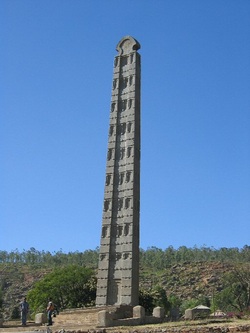
The Aksumite Empire or Axumite Empire (sometimes called the Kingdom of Aksum or Axum), (Africa, growing from the proto-Aksumite period ca. 4th century BC to achieve prominence by the 1st century AD. It was a major player in the commerce between the Roman Empire and Ancient India and the Aksumite rulers facilitated trade by minting their own currency. The state established its hegemony over the declining Kingdom of Kush and regularly entered the politics of the kingdoms on the Arabian peninsula, and would eventually extend its rule over the region with the conquest of the Himyarite Kingdom.
Under Ezana Aksum became the first major empire to convert to Christianity and was named by Mani as one of the four great powers of his time along with Persia, Rome, and China. In the 7th century the Muslims who originally converged in Mecca, sought refuge from Quraysh persecution by travelling to Aksum which is known in Islamic history as the First Hijra. Its ancient capital is found in northern Ethiopia. The Kingdom used the name "Ethiopia" as early as the 4th century.[2][3] It is also the alleged resting place of the Ark of the Covenant[dubious – discuss]and the purported home of the Queen of Sheba
Historical records
Aksum is mentioned in the 1st century AD Periplus of the Erythraean Sea as an important market place for ivory, which was exported throughout the ancient world, and states that the ruler of Aksum in the 1st century AD was Zoskales, who, besides ruling in Aksum also controlled two harbours on the Red Sea: Adulis (near Massawa) and Avalites (Assab) located in Eritrea. He is also said to have been familiar with Greek literature.[4]
History
Origins Aksum was previously thought to have been founded by Semitic-speaking Sabaeans who crossed the Red Sea from South Arabia (modern Yemen) on the basis of Conti Rossini's theories and prolific work on Ethiopian history—but most scholars now agree that it was an indigenous African development.[2][5]
Scholars like Stuart Munro-Hay point to the existence of an older D’mt or Da'amot kingdom, prior to any Sabaean migration ca. 4th or 5th c. BC, as well as to evidence of Sabaean immigrants having resided in the region for little more than a few decades.[2] Furthermore, Ge'ez, the ancient Semitic language of Eritrea and Ethiopia, is now known not to have derived from Sabaean, and there is evidence of a Semitic speaking presence in Ethiopia and Eritrea at least as early as 2000 BC.[2][6]
Sabaean influence is now thought to have been minor, limited to a few localities, and disappearing after a few decades or a century, perhaps representing a trading or military colony in some sort of symbiosis or military alliance with the civilization of D`mt or some proto-Aksumite state.[2] Confusingly, there existed an Ethiopian city called Saba in the ancient period that does not seem to have been a Sabaean settlement.
Empire
The Empire of Aksum at its height extended across most of present-day Eritrea, northern Ethiopia, Yemen, southern Saudi Arabia and northern Sudan. The capital city of the empire was Aksum, now in northern Ethiopia. Today a smaller community, the city of Aksum was once a bustling metropolis, cultural and economic center. Two hills and two streams lie on the east and west expanses of the city; perhaps providing the initial impetus for settling this area. Along the hills and plain outside the city, the Aksumites had cemeteries with elaborate grave stones called stelae, or obelisks. Other important cities included Yeha, Hawulti, Matara, Adulis, and Qohaito, the last three of which are now in Eritrea.
In the 3rd century, Aksum began interfering in South Arabian affairs, controlling at times the western Tihama region among other areas. It dominated states on the Arabian Peninsula across the Red Sea, making them pay Axum a regular tribute.[7] By the late 3rd century it had begun minting its own currency and was named by Mani as one of the four great powers of his time along with Persia, Rome, and China. It converted to Christianity in 325 or 328 under King Ezana and was the first state ever to use the image of the cross on its coins. By 350, they conquered the Kingdom of Kush.[7] At its height, Aksum controlled northern Ethiopia, Eritrea, northern Sudan, southern Egypt, Djibouti, Yemen, and southern Saudi Arabia, totalling 1.25 million km².[8]
Aksum remained a strong empire and trading power until the rise of Islam in the 7th century. However, unlike the relations between the Islamic powers and Christian Europe, Axum, which provided shelter to Muhammad's early followers, was on good terms with its Islamic neighbors.[7] Nevertheless, as early as 640, Umar ibn al-Khattāb sent a naval expedition against Adulis under Alkama bin Mujazziz, but it was eventually defeated.[9] Axumite naval power also declined throughout the period, though in 702 Aksumite were able to invade the Hejaz and occupy Jeddah. In retaliation, however, Sulayman ibn Abd al-Malik was able to take the Dahlak Archipelago from Axum, which became Muslim from that point on, though later recovered in the 9th century and vassal to the Emperor of Ethiopia.[10]
Decline
Eventually, the Islamic Empire took control of the Red Sea and most of the Nile, forcing Axum into economic isolation.[7] Northwest of Axum (in modern day Sudan), Christian states of Maqurra and Alwa lasted till the 13th century before becoming Islamic.[7] Axum, isolated, nonetheless still remained Christian.[7]
After a second golden age in the early 6th century, the empire began to decline, eventually ceasing its production of coins in the early 7th century. Around this same time, the Aksumite population was forced to go farther inland to the highlands for protection. Local history hold that a Jewish Queen named Yodit (Judith) or "Gudit" defeated the empire and burned its churches and literature, but while there is evidence of churches being burned and an invasion around this time, her existence has been questioned by some modern authors.[citation needed]
Another possibility is that the Axumite power was ended by a southern pagan queen named Bani al-Hamwiyah, possibly of the tribe al-Damutah or Damoti (Sidama). After a short Dark Age, the Axumite Empire was succeeded by the Zagwe dynasty in the 11th century or 12th century, although limited in size and scope. However, Yekuno Amlak, who killed the last Zagwe king and founded the modern Solomonic dynasty traced his ancestry and his right to rule from the last emperor of Axum, Dil Na'od.
Other reasons for the decline are less romantic and more scientific. Climate change and trade isolation are probably also large reasons for the decline of the culture. Overfarming of the land led to decreased crop yield, which in turn led to decreased food supply. This, in turn with the changing flood pattern of the Nile and several seasons of drought, would make it less important in the emerging European economy.
Foreign relations, trade and economy
Covering parts of what is now northern Ethiopia and Eritrea, Aksum was deeply involved in the trade network between India and the Mediterranean (Rome, later Byzantium)), exporting ivory, tortoise shell, gold and emeralds, and importing silk and spices.[11] Axum's access to both the Red Sea and the Upper Nile enabled its strong navy to profit in trade between various African (Nubia), Arabian (Yemen), and Indian states.[11]
The main exports of Axum were, as would be expected of a state during this time, agricultural products. The land was much more fertile during the time of the Aksumites than now, and their principal crops were grains such as wheat and barley. The people of Aksum also raised cattle, sheep, and camels. Wild animals were also hunted for things such as ivory and rhinoceros horns. They traded with Roman traders as well as with Egyptian and Persian merchants. The empire was also rich with gold and iron deposits. These metals were valuable to trade, but another mineral was also widely traded. Salt was found richly in Aksum and was traded quite frequently.
It benefited from a major transformation of the maritime trading system that linked the Roman Empire and India. This change took place around the start of the Common Era. The older trading system involved coastal sailing and many intermediary ports. The Red Sea was of secondary importance to the Persian Gulf and overland connections to the Levant. Starting around 100 BC a route from Egypt to India was established, making use of the Red Sea and using monsoon winds to cross the Arabian Sea directly to southern India. By about 100 AD the volume of traffic being shipped on this route had eclipsed older routes. Roman demand for goods from southern India increased dramatically, resulting in greater number of large ships sailing down the Red Sea from Roman rule in Egypt to the Arabian Sea and India.
The Kingdom of Aksum was ideally located to take advantage of the new trading situation. Adulis soon became the main port for the export of African goods, such as ivory, incense, gold, slaves, and exotic animals. In order to supply such goods the kings of Aksum worked to develop and expand an inland trading network. A rival, and much older trading network that tapped the same interior region of Africa was that of the Kingdom of Kush, which had long supplied Egypt with African goods via the Nile corridor. By the 1st century AD, however, Aksum had gained control over territory previously Kushite. The Periplus of the Erythraean Sea explicitly describes how ivory collected in Kushite territory was being exported through the port of Adulis instead of being taken to Meroë, the capital of Kush. During the 2nd and 3rd centuries the Kingdom of Aksum continued to expand their control of the southern Red Sea basin. A caravan route to Egypt was established which bypassed the Nile corridor entirely. Aksum succeeded in becoming the principal supplier of African goods to the Roman Empire, not least as a result of the transformed Indian Ocean trading system.[12]
Society
The Aksumite population consisted of Semitic-speaking people (collectively known as Habeshas),[13][14][15] Cushitic-speaking people, and Nilo-Saharan-speaking people (the Kunama and Nara).
The Aksumite kings had the official title ነገሠ ፡ ነገሠተ ngś ngśt - King of Kings (later vocalization Ge'ez ንጉሠ ፡ ነገሥት nigūśa nagaśt, Modern Ethiosemitic nigūse negest).
Aksumites did own slaves, and a modified feudal system was in place to farm the land.
Culture
The Empire of Aksum is notable for a number of achievements, such as its own alphabet, the Ge'ez alphabet (which evolved from Epigraphic South Arabian during the late pre-Aksumite and proto-Aksumite period), which was modified to include vowels, becoming an abugida. Furthermore, in the early times of the empire, around 1700 years ago, giant Obelisks to mark emperor's (and nobles') tombstones (underground grave chambers) were constructed, the most famous of which is the Obelisk of Axum.
Under Emperor Ezana, Axum adopted Christianity in place of its former polytheistic and Judaic religions around 325. This gave rise to the present day Ethiopian Orthodox Tewahedo Church (only granted autonomy from the Coptic Church in 1959), and Eritrean Orthodox Tewahdo Church (granted autonomy from the Ethiopian Orthodox church in 1993). Since the schism with orthodoxy following the Council of Chalcedon (451), it has been an important Miaphysite church, and its scriptures and liturgy continue to be in Ge'ez.[7]
It was a cosmopolitan state.[7] Culturally, it was a meeting place for a variety of people: Ethiopian, Egyptian, Sudanic, Arabic, and Indian.[7] The largest cities of the realm had Sabean, Jewish, Nubian, Christian, and even Buddhist minorities.[7]
Religion
Before its conversion to Christianity the Aksumites practiced a polytheistic religion.[7] Astar was the main god of the pre-Christian Aksumites; his son, Mahrem (Maher), was to whom the kings of Aksum traced their lineage. In about 324 AD the King Ezana II was converted by his slave-teacher Frumentius, the founder of the Ethiopian Orthodox Church.[7][11] Frumentius taught the emperor while he was young, and at some point staged the conversion of the empire.[7][11] We know that the Axumites converted to Christianity because in their coins they replaced the disc and crescent with the cross. Frumentius was in contact with the Church in Alexandria and was appointed Bishop of Ethiopia around 330 AD. The Church of Alexandria never reined Aksum in tightly, rather allowing its own form of Christianity to develop; however it did retain some influence and the Ethiopian Church followed the Coptic Church of Alexandria into Monophysitism after the Council of Chalcedon. Aksum is also the alleged home of the holy relic the Ark of the Covenant. The Ark is said to have been placed in the Church of Our Lady Mary of Zion by Menelik I for safekeeping.
Coinage
The Empire of Aksum was the first African polity economically and politically ambitious enough to issue its own coins, which bore legends in Ge'ez and Greek. From the reign of Endubis up to Armah (approximately 270 to 610), gold, silver and bronze coins were minted. Issuing coinage in ancient times was an act of great importance in itself, for it proclaimed that the Axumite Empire considered itself equal to its neighbors. Many of the coins are used as signposts about what was happening when they were minted. An example being the addition of the cross to the coin after the conversion of the empire to Christianity. The presence of coins also simplified trade, and was at once a useful instrument of propaganda and a source of profit to the empire.
Stelae
The Stelae are perhaps the most identifiable part of the Aksumite legacy. These stone towers served to mark graves or represent a magnificent building. The largest of these towering obelisks would measure 33 meters high had it not fallen. The Stelae have most of their mass out of the ground, but are stabilized by massive underground counter-weights. The stone was often engraved with a pattern or emblem denoting the king's or the noble's rank.
In fiction The Aksumite Empire is portrayed as the main ally of Byzantium in the Belisarius series by David Drake and Eric Flint published by Baen Books. The series takes place during the reign of Kaleb of Axum, who in the series was assassinated by the Malwa in 532 at the Ta'akha Maryam and succeeded by his youngest son Eon bisi Dakuen.
In Elizabeth Wein's series The Lion Hunters, Mordred and his family take refuge in Aksum after the fall of Camelot. Kaleb is the ruler in the first book; he passes his sovereignty onto his son Gebre Meskal, who rules during the Plague of Justinian.
[edit] See also [edit] External links
Under Ezana Aksum became the first major empire to convert to Christianity and was named by Mani as one of the four great powers of his time along with Persia, Rome, and China. In the 7th century the Muslims who originally converged in Mecca, sought refuge from Quraysh persecution by travelling to Aksum which is known in Islamic history as the First Hijra. Its ancient capital is found in northern Ethiopia. The Kingdom used the name "Ethiopia" as early as the 4th century.[2][3] It is also the alleged resting place of the Ark of the Covenant[dubious – discuss]and the purported home of the Queen of Sheba
Historical records
Aksum is mentioned in the 1st century AD Periplus of the Erythraean Sea as an important market place for ivory, which was exported throughout the ancient world, and states that the ruler of Aksum in the 1st century AD was Zoskales, who, besides ruling in Aksum also controlled two harbours on the Red Sea: Adulis (near Massawa) and Avalites (Assab) located in Eritrea. He is also said to have been familiar with Greek literature.[4]
History
Origins Aksum was previously thought to have been founded by Semitic-speaking Sabaeans who crossed the Red Sea from South Arabia (modern Yemen) on the basis of Conti Rossini's theories and prolific work on Ethiopian history—but most scholars now agree that it was an indigenous African development.[2][5]
Scholars like Stuart Munro-Hay point to the existence of an older D’mt or Da'amot kingdom, prior to any Sabaean migration ca. 4th or 5th c. BC, as well as to evidence of Sabaean immigrants having resided in the region for little more than a few decades.[2] Furthermore, Ge'ez, the ancient Semitic language of Eritrea and Ethiopia, is now known not to have derived from Sabaean, and there is evidence of a Semitic speaking presence in Ethiopia and Eritrea at least as early as 2000 BC.[2][6]
Sabaean influence is now thought to have been minor, limited to a few localities, and disappearing after a few decades or a century, perhaps representing a trading or military colony in some sort of symbiosis or military alliance with the civilization of D`mt or some proto-Aksumite state.[2] Confusingly, there existed an Ethiopian city called Saba in the ancient period that does not seem to have been a Sabaean settlement.
Empire
The Empire of Aksum at its height extended across most of present-day Eritrea, northern Ethiopia, Yemen, southern Saudi Arabia and northern Sudan. The capital city of the empire was Aksum, now in northern Ethiopia. Today a smaller community, the city of Aksum was once a bustling metropolis, cultural and economic center. Two hills and two streams lie on the east and west expanses of the city; perhaps providing the initial impetus for settling this area. Along the hills and plain outside the city, the Aksumites had cemeteries with elaborate grave stones called stelae, or obelisks. Other important cities included Yeha, Hawulti, Matara, Adulis, and Qohaito, the last three of which are now in Eritrea.
In the 3rd century, Aksum began interfering in South Arabian affairs, controlling at times the western Tihama region among other areas. It dominated states on the Arabian Peninsula across the Red Sea, making them pay Axum a regular tribute.[7] By the late 3rd century it had begun minting its own currency and was named by Mani as one of the four great powers of his time along with Persia, Rome, and China. It converted to Christianity in 325 or 328 under King Ezana and was the first state ever to use the image of the cross on its coins. By 350, they conquered the Kingdom of Kush.[7] At its height, Aksum controlled northern Ethiopia, Eritrea, northern Sudan, southern Egypt, Djibouti, Yemen, and southern Saudi Arabia, totalling 1.25 million km².[8]
Aksum remained a strong empire and trading power until the rise of Islam in the 7th century. However, unlike the relations between the Islamic powers and Christian Europe, Axum, which provided shelter to Muhammad's early followers, was on good terms with its Islamic neighbors.[7] Nevertheless, as early as 640, Umar ibn al-Khattāb sent a naval expedition against Adulis under Alkama bin Mujazziz, but it was eventually defeated.[9] Axumite naval power also declined throughout the period, though in 702 Aksumite were able to invade the Hejaz and occupy Jeddah. In retaliation, however, Sulayman ibn Abd al-Malik was able to take the Dahlak Archipelago from Axum, which became Muslim from that point on, though later recovered in the 9th century and vassal to the Emperor of Ethiopia.[10]
Decline
Eventually, the Islamic Empire took control of the Red Sea and most of the Nile, forcing Axum into economic isolation.[7] Northwest of Axum (in modern day Sudan), Christian states of Maqurra and Alwa lasted till the 13th century before becoming Islamic.[7] Axum, isolated, nonetheless still remained Christian.[7]
After a second golden age in the early 6th century, the empire began to decline, eventually ceasing its production of coins in the early 7th century. Around this same time, the Aksumite population was forced to go farther inland to the highlands for protection. Local history hold that a Jewish Queen named Yodit (Judith) or "Gudit" defeated the empire and burned its churches and literature, but while there is evidence of churches being burned and an invasion around this time, her existence has been questioned by some modern authors.[citation needed]
Another possibility is that the Axumite power was ended by a southern pagan queen named Bani al-Hamwiyah, possibly of the tribe al-Damutah or Damoti (Sidama). After a short Dark Age, the Axumite Empire was succeeded by the Zagwe dynasty in the 11th century or 12th century, although limited in size and scope. However, Yekuno Amlak, who killed the last Zagwe king and founded the modern Solomonic dynasty traced his ancestry and his right to rule from the last emperor of Axum, Dil Na'od.
Other reasons for the decline are less romantic and more scientific. Climate change and trade isolation are probably also large reasons for the decline of the culture. Overfarming of the land led to decreased crop yield, which in turn led to decreased food supply. This, in turn with the changing flood pattern of the Nile and several seasons of drought, would make it less important in the emerging European economy.
Foreign relations, trade and economy
Covering parts of what is now northern Ethiopia and Eritrea, Aksum was deeply involved in the trade network between India and the Mediterranean (Rome, later Byzantium)), exporting ivory, tortoise shell, gold and emeralds, and importing silk and spices.[11] Axum's access to both the Red Sea and the Upper Nile enabled its strong navy to profit in trade between various African (Nubia), Arabian (Yemen), and Indian states.[11]
The main exports of Axum were, as would be expected of a state during this time, agricultural products. The land was much more fertile during the time of the Aksumites than now, and their principal crops were grains such as wheat and barley. The people of Aksum also raised cattle, sheep, and camels. Wild animals were also hunted for things such as ivory and rhinoceros horns. They traded with Roman traders as well as with Egyptian and Persian merchants. The empire was also rich with gold and iron deposits. These metals were valuable to trade, but another mineral was also widely traded. Salt was found richly in Aksum and was traded quite frequently.
It benefited from a major transformation of the maritime trading system that linked the Roman Empire and India. This change took place around the start of the Common Era. The older trading system involved coastal sailing and many intermediary ports. The Red Sea was of secondary importance to the Persian Gulf and overland connections to the Levant. Starting around 100 BC a route from Egypt to India was established, making use of the Red Sea and using monsoon winds to cross the Arabian Sea directly to southern India. By about 100 AD the volume of traffic being shipped on this route had eclipsed older routes. Roman demand for goods from southern India increased dramatically, resulting in greater number of large ships sailing down the Red Sea from Roman rule in Egypt to the Arabian Sea and India.
The Kingdom of Aksum was ideally located to take advantage of the new trading situation. Adulis soon became the main port for the export of African goods, such as ivory, incense, gold, slaves, and exotic animals. In order to supply such goods the kings of Aksum worked to develop and expand an inland trading network. A rival, and much older trading network that tapped the same interior region of Africa was that of the Kingdom of Kush, which had long supplied Egypt with African goods via the Nile corridor. By the 1st century AD, however, Aksum had gained control over territory previously Kushite. The Periplus of the Erythraean Sea explicitly describes how ivory collected in Kushite territory was being exported through the port of Adulis instead of being taken to Meroë, the capital of Kush. During the 2nd and 3rd centuries the Kingdom of Aksum continued to expand their control of the southern Red Sea basin. A caravan route to Egypt was established which bypassed the Nile corridor entirely. Aksum succeeded in becoming the principal supplier of African goods to the Roman Empire, not least as a result of the transformed Indian Ocean trading system.[12]
Society
The Aksumite population consisted of Semitic-speaking people (collectively known as Habeshas),[13][14][15] Cushitic-speaking people, and Nilo-Saharan-speaking people (the Kunama and Nara).
The Aksumite kings had the official title ነገሠ ፡ ነገሠተ ngś ngśt - King of Kings (later vocalization Ge'ez ንጉሠ ፡ ነገሥት nigūśa nagaśt, Modern Ethiosemitic nigūse negest).
Aksumites did own slaves, and a modified feudal system was in place to farm the land.
Culture
The Empire of Aksum is notable for a number of achievements, such as its own alphabet, the Ge'ez alphabet (which evolved from Epigraphic South Arabian during the late pre-Aksumite and proto-Aksumite period), which was modified to include vowels, becoming an abugida. Furthermore, in the early times of the empire, around 1700 years ago, giant Obelisks to mark emperor's (and nobles') tombstones (underground grave chambers) were constructed, the most famous of which is the Obelisk of Axum.
Under Emperor Ezana, Axum adopted Christianity in place of its former polytheistic and Judaic religions around 325. This gave rise to the present day Ethiopian Orthodox Tewahedo Church (only granted autonomy from the Coptic Church in 1959), and Eritrean Orthodox Tewahdo Church (granted autonomy from the Ethiopian Orthodox church in 1993). Since the schism with orthodoxy following the Council of Chalcedon (451), it has been an important Miaphysite church, and its scriptures and liturgy continue to be in Ge'ez.[7]
It was a cosmopolitan state.[7] Culturally, it was a meeting place for a variety of people: Ethiopian, Egyptian, Sudanic, Arabic, and Indian.[7] The largest cities of the realm had Sabean, Jewish, Nubian, Christian, and even Buddhist minorities.[7]
Religion
Before its conversion to Christianity the Aksumites practiced a polytheistic religion.[7] Astar was the main god of the pre-Christian Aksumites; his son, Mahrem (Maher), was to whom the kings of Aksum traced their lineage. In about 324 AD the King Ezana II was converted by his slave-teacher Frumentius, the founder of the Ethiopian Orthodox Church.[7][11] Frumentius taught the emperor while he was young, and at some point staged the conversion of the empire.[7][11] We know that the Axumites converted to Christianity because in their coins they replaced the disc and crescent with the cross. Frumentius was in contact with the Church in Alexandria and was appointed Bishop of Ethiopia around 330 AD. The Church of Alexandria never reined Aksum in tightly, rather allowing its own form of Christianity to develop; however it did retain some influence and the Ethiopian Church followed the Coptic Church of Alexandria into Monophysitism after the Council of Chalcedon. Aksum is also the alleged home of the holy relic the Ark of the Covenant. The Ark is said to have been placed in the Church of Our Lady Mary of Zion by Menelik I for safekeeping.
Coinage
The Empire of Aksum was the first African polity economically and politically ambitious enough to issue its own coins, which bore legends in Ge'ez and Greek. From the reign of Endubis up to Armah (approximately 270 to 610), gold, silver and bronze coins were minted. Issuing coinage in ancient times was an act of great importance in itself, for it proclaimed that the Axumite Empire considered itself equal to its neighbors. Many of the coins are used as signposts about what was happening when they were minted. An example being the addition of the cross to the coin after the conversion of the empire to Christianity. The presence of coins also simplified trade, and was at once a useful instrument of propaganda and a source of profit to the empire.
Stelae
The Stelae are perhaps the most identifiable part of the Aksumite legacy. These stone towers served to mark graves or represent a magnificent building. The largest of these towering obelisks would measure 33 meters high had it not fallen. The Stelae have most of their mass out of the ground, but are stabilized by massive underground counter-weights. The stone was often engraved with a pattern or emblem denoting the king's or the noble's rank.
In fiction The Aksumite Empire is portrayed as the main ally of Byzantium in the Belisarius series by David Drake and Eric Flint published by Baen Books. The series takes place during the reign of Kaleb of Axum, who in the series was assassinated by the Malwa in 532 at the Ta'akha Maryam and succeeded by his youngest son Eon bisi Dakuen.
In Elizabeth Wein's series The Lion Hunters, Mordred and his family take refuge in Aksum after the fall of Camelot. Kaleb is the ruler in the first book; he passes his sovereignty onto his son Gebre Meskal, who rules during the Plague of Justinian.
[edit] See also [edit] External links
- East-West Orientations of Historical Empires
- Civilizations in Africa: Axum
- Ancient Horn of Africa:Axum
- Ethiopian Treasures - Queen of Sheba, Aksumite Kingdom - Aksum
- Ancient History Sourcebook: Accounts of Meröe, Kush, and Axum
- Francis Anfray. Les anciens ethiopiens. Paris: Armand Colin, 1991.
- Carlo Conti Rossini. Storia d'Etiopia. Bergamo: Istituto Italiano d'Arti Grafiche, 1928.
- Stuart Munro-Hay. Aksum: A Civilization of Late Antiquity. Edinburgh: University Press. 1991. ISBN 0-7486-0106-6
- Yuri M. Kobishchanov. Axum (Joseph W. Michels, editor; Lorraine T. Kapitanoff, translator). University Park, Pennsylvania: Penn State University Press, 1979. ISBN 0-271-00531-9
- Karl W. Butzer. Rise and Fall of Axum, Ethiopia: A Geo-Archaeological Interpretation. American Antiquity, Vol. 46, No. 3. (Jul., 1981), pp. 471–495.
- Joseph W. Michels. Changing settlement patterns in the Aksum-Yeha region of Ethiopia: 700 BC - AD 850 (BAR International Series 1448) Oxford: Archaeopress, 2005.
- Mukhtār, Muḥammad Jamāl al-Dīn. 1981. Ancient civilizations of Africa. General history of Africa, 2. London: Heinemann Educational Books.ISBN 9780435948054
- David W. Phillipson. Ancient Ethiopia. Aksum: Its antecedents and successors. London: The British Museum, 1998.
- David W. Phillipson. Archaeology at Aksum, Ethiopia, 1993-97. London: British Institute in Eastern Africa, 2000.
- Williams, Stephen. "Ethiopia: Africa's Holy Land". New African, Vol. 458. ( Jan., 2007), pp 94–97.
- Belai Giday. Ethiopian Civilization. Addis Ababa, 1992
Zoskales possibly the "Za Haqala" from the King List
c. 100

Zoskales (c. 100) was a king in the Horn of Africa, whose realm is thought to include Axum.
The Periplus of the Erythraean Sea mentions him as ruler of the port of Adulis, whose territory extended "from the Moschophagoi ['calf-eaters'] to the rest of Barbaria ... a stickler about his possessions and always holding out for getting more, but in other respects a fine person and well versed in reading and writing Greek".[1]
At least as early as Henry Salt, some scholars, including Sergew Hable Sellassie[2] and Y. M. Kobishchanov,[3] have identified him with Za Haqala, who is listed in the King Lists of Ethiopia as having ruled for 13 years, and who ruled between Za Zalis and Za Dembalé.[4] G.W.B. Huntingford points out, on the other hand, that there is not enough information to be certain of this identification, and argues instead that Zoskales was a petty king whose power was limited to only Adulis.[5]
Notes
The Periplus of the Erythraean Sea mentions him as ruler of the port of Adulis, whose territory extended "from the Moschophagoi ['calf-eaters'] to the rest of Barbaria ... a stickler about his possessions and always holding out for getting more, but in other respects a fine person and well versed in reading and writing Greek".[1]
At least as early as Henry Salt, some scholars, including Sergew Hable Sellassie[2] and Y. M. Kobishchanov,[3] have identified him with Za Haqala, who is listed in the King Lists of Ethiopia as having ruled for 13 years, and who ruled between Za Zalis and Za Dembalé.[4] G.W.B. Huntingford points out, on the other hand, that there is not enough information to be certain of this identification, and argues instead that Zoskales was a petty king whose power was limited to only Adulis.[5]
Notes
- ^ Chapter 5 Online translation
- ^ Ancient and Medieval Ethiopian History to 1270 (Addis Ababa: 1972), p. 72
- ^ Axum (University Park: 1979), pp. 54-5
- ^ Salt, A Voyage to Abyssinia (Philadelphia, 1816), p. 358
- ^ Quoted in Paul B. Henze, Layers of Time: A History of Ethiopia (New York: Palgrave, 2000), p. 18
GDRT (vocalized by historians as "Gadarat")
c. 200

GDRT (also GDR, vocalized by historians as Gadarat) was a king of the Kingdom of Aksum (c.200), known for being the first king to involve Axum in the affairs of what is now Yemen. He is known primarily from inscriptions in South Arabia that mention him and his son BYGT (also vocalized as "Beyga" or "Beygat"). GDRT is thought to be the same person as GDR, the name inscribed on a bronze wand or sceptre that was found in an area near Atsbi and Dar'a near Addi Galamo in northern Ethiopia.[1] GDRT has been equated with the anonymous king of the Monumentum Adulitanum, which would date his reign c. 200 – c. 230; however, the two are usually thought to be distinct.[2]
Aksumite inscription
The inscriptions of GDR represent the oldest surviving royal inscriptions in the Ge'ez alphabet.[3] The oldest of these was found at Addi Galamo in the regions of Atsbi and Dar'a in eastern Tigray Region in northern Ethiopia. The area is rich in pre-Aksumite artifacts,[4] and inscriptions of a pre-Aksumite kingdom called Dʿmt have been found in the region. The inscription mentioning GDR is the only evidence of his existence from the western side of the Red Sea:
gdr / ngśy / ʾksm / tbʿl / mzlt / lʾrg / wllmq[3] The Addi Galamo inscription was written on a sceptre or "boomerang-like object";[5] the linguist A.J. Drewes therefore interprets mzlt as meaning a sceptre or royal emblem. The inscription's meaning is uncertain, but if mzlt is taken to mean a sceptre, and ʾrg and lmq are taken to be place names (or sanctuaries), then, according to Alexander Sima, the text could mean "GDR, king of Aksum gave (this) sceptre into the possession of (the sanctuaries) ʾRG and LMQ."[5] The South Arabian expert W.F. Albert Jamme, however, translates the inscription as "GDR king of Aksum occupied the passages of `RG and LMQ", or "Gedara, King of Axum is humbled before the [gods] Arg and Almouqah," (i.e. Almaqah or Ilmuqah), assuming that the ʾ in Ilmuqah was assimilated.[6]
South Arabian involvement
GDRT is first mentioned in South Arabian inscriptions as an ally of `Alhan Nahfan, king of Saba, in an inscription at Mahram Bilqis, at Ma'rib in Yemen, the temple of the moon god Ilmuqah.[7] According to Stuart Munro-Hay, the inscription reads
they agreed together that their war and their peace should be in unison, against anyone that might rise up against them, and that in safety and in security there should be allied together Salhen and Zararan and `Alhan and Gadarat.[8] Alexander Sima translates the text slightly differently, specifying that it was GDRT who "sent a diplomatic mission to [`Ahlan] in order to form an alliance."[5] Both interpret "Zararan" or "Zrrn" as the name of the palace in Aksum at the time, parallel to "Sahlen," the palace of Saba in Marib.[5][8] This Sahlen-Saba parallel, along with the Dhu-Raydan-Himyar parallel, was often used by Aksumite kings in their inscriptions enumerating the territories under their control. A Himyarite inscription confirms the Sabaean text, mentioning that Aksum, Saba', Hadramaut, and Qataban were all allied against Himyar.[5] `Alhan Nafhan's son Sha`ir Awtar or Sha`irum Awtar later abandoned the alliance with GDRT after he became king of Saba.[8] However, during the first part of Sha`ir Awtar's reign, the two powers seem to have joined in an alliance once again, this time against Hadramaut.[5] Saba's invasion of Hadramaut with Aksumite help culminated in the latter's defeat and the occupation of its capital, Shabwa, in 225. Sha`ir Awtar's attack represented a major shift in policy as, before the attack, the king of Hadhramaut, Il`azz Yalut, was married to his sister; he had even helped suppress a revolt against Il`azz Yalut.[8]
Although Saba' was previously allied with Aksum against Himyar, both Himyarite and Sabaean troops were used in the attack against Hadramaut. Immediately following the conquest of Hadramaut, Sha`ir Awtar allied with Himyar against his former ally GDRT.[8] A second Sabaean inscription from the sanctuary 'Awam in Marib during the reign of Sha`ir Awtar's successor, Luha`atht Yarhum, describes events in the latter part of his predecessor's reign. The inscription tells of a diplomatic mission sent by Sha`ir Awtar to GDRT, the results of which are unknown; however, the text later goes on to describe a war between Saba and Aksum in the southern highlands of Yemen, implying that the negotiations were futile.[5] Aksum lost a battle as a result of the Saba'-Himyar alliance, allowing the South Arabian forces to expel GDRT's son BYGT and his forces from the Himyarite capital Zafar, which had previously been held by Aksum after the Aksum-Hadramaut-Qataban-Saba alliance.[8] Despite this loss, Aksum still held territory in South Arabia, as evidenced by inscriptions of Luha`atht Yarhum (r. ca. 230), which detail at least one known clash with hbšt troops in Yemen after GDRT's reign.[8] Peace may have been established after GDRT's death, but war and Aksumite involvement was renewed under his successors such as `DBH and GRMT, and the whole third century was to be dominated by Ethio-Yemeni conflicts.[5][8]
Legacy
GDRT was most likely the first Aksumite king to be involved in South Arabian affairs, as well as the first known king to be mentioned in South Arabian inscriptions.[5] His reign resulted in the control of much of western Yemen, such as the Tihama, Najran, Ma`afir, Zafar (until c. 230), and parts of Hashid territory around Hamir in the northern highlands.[5] Furthermore, GDRT's military alliances and his conquests in Yemen and Saudi Arabia, the required formidable fleet for such feats, and the extension of Aksumite influence throughout Yemen and southern Saudi Arabia all reflect a new zenith in Aksumite power.[8] His involvement would mark the beginning of centuries of Aksumite involvement in South Arabia, culminating with the full-scale invasion of Yemen by King Kaleb in 520 (or 525), resulting in the establishment of an Aksumite province covering all of South Arabia.
GDRT's name may be preserved in Ethiopian tradition through the traditional king lists, as what seem to be variants of his name crop up in three of them. Gədur is listed as the third king in list C, Zegduru (ze meaning 'of' in Ge'ez) appears as the sixth in list E, and Zegdur appears as the third in list B, after the legendary Menelik I. Zegdur also is mentioned in at least one hagiography and short chronicle.[5] The king lists were composed centuries after the fall of the Aksumite kingdom, however, and generally do not agree with archaeological records except when concerning famous kings.[9]
See also References
Aksumite inscription
The inscriptions of GDR represent the oldest surviving royal inscriptions in the Ge'ez alphabet.[3] The oldest of these was found at Addi Galamo in the regions of Atsbi and Dar'a in eastern Tigray Region in northern Ethiopia. The area is rich in pre-Aksumite artifacts,[4] and inscriptions of a pre-Aksumite kingdom called Dʿmt have been found in the region. The inscription mentioning GDR is the only evidence of his existence from the western side of the Red Sea:
gdr / ngśy / ʾksm / tbʿl / mzlt / lʾrg / wllmq[3] The Addi Galamo inscription was written on a sceptre or "boomerang-like object";[5] the linguist A.J. Drewes therefore interprets mzlt as meaning a sceptre or royal emblem. The inscription's meaning is uncertain, but if mzlt is taken to mean a sceptre, and ʾrg and lmq are taken to be place names (or sanctuaries), then, according to Alexander Sima, the text could mean "GDR, king of Aksum gave (this) sceptre into the possession of (the sanctuaries) ʾRG and LMQ."[5] The South Arabian expert W.F. Albert Jamme, however, translates the inscription as "GDR king of Aksum occupied the passages of `RG and LMQ", or "Gedara, King of Axum is humbled before the [gods] Arg and Almouqah," (i.e. Almaqah or Ilmuqah), assuming that the ʾ in Ilmuqah was assimilated.[6]
South Arabian involvement
GDRT is first mentioned in South Arabian inscriptions as an ally of `Alhan Nahfan, king of Saba, in an inscription at Mahram Bilqis, at Ma'rib in Yemen, the temple of the moon god Ilmuqah.[7] According to Stuart Munro-Hay, the inscription reads
they agreed together that their war and their peace should be in unison, against anyone that might rise up against them, and that in safety and in security there should be allied together Salhen and Zararan and `Alhan and Gadarat.[8] Alexander Sima translates the text slightly differently, specifying that it was GDRT who "sent a diplomatic mission to [`Ahlan] in order to form an alliance."[5] Both interpret "Zararan" or "Zrrn" as the name of the palace in Aksum at the time, parallel to "Sahlen," the palace of Saba in Marib.[5][8] This Sahlen-Saba parallel, along with the Dhu-Raydan-Himyar parallel, was often used by Aksumite kings in their inscriptions enumerating the territories under their control. A Himyarite inscription confirms the Sabaean text, mentioning that Aksum, Saba', Hadramaut, and Qataban were all allied against Himyar.[5] `Alhan Nafhan's son Sha`ir Awtar or Sha`irum Awtar later abandoned the alliance with GDRT after he became king of Saba.[8] However, during the first part of Sha`ir Awtar's reign, the two powers seem to have joined in an alliance once again, this time against Hadramaut.[5] Saba's invasion of Hadramaut with Aksumite help culminated in the latter's defeat and the occupation of its capital, Shabwa, in 225. Sha`ir Awtar's attack represented a major shift in policy as, before the attack, the king of Hadhramaut, Il`azz Yalut, was married to his sister; he had even helped suppress a revolt against Il`azz Yalut.[8]
Although Saba' was previously allied with Aksum against Himyar, both Himyarite and Sabaean troops were used in the attack against Hadramaut. Immediately following the conquest of Hadramaut, Sha`ir Awtar allied with Himyar against his former ally GDRT.[8] A second Sabaean inscription from the sanctuary 'Awam in Marib during the reign of Sha`ir Awtar's successor, Luha`atht Yarhum, describes events in the latter part of his predecessor's reign. The inscription tells of a diplomatic mission sent by Sha`ir Awtar to GDRT, the results of which are unknown; however, the text later goes on to describe a war between Saba and Aksum in the southern highlands of Yemen, implying that the negotiations were futile.[5] Aksum lost a battle as a result of the Saba'-Himyar alliance, allowing the South Arabian forces to expel GDRT's son BYGT and his forces from the Himyarite capital Zafar, which had previously been held by Aksum after the Aksum-Hadramaut-Qataban-Saba alliance.[8] Despite this loss, Aksum still held territory in South Arabia, as evidenced by inscriptions of Luha`atht Yarhum (r. ca. 230), which detail at least one known clash with hbšt troops in Yemen after GDRT's reign.[8] Peace may have been established after GDRT's death, but war and Aksumite involvement was renewed under his successors such as `DBH and GRMT, and the whole third century was to be dominated by Ethio-Yemeni conflicts.[5][8]
Legacy
GDRT was most likely the first Aksumite king to be involved in South Arabian affairs, as well as the first known king to be mentioned in South Arabian inscriptions.[5] His reign resulted in the control of much of western Yemen, such as the Tihama, Najran, Ma`afir, Zafar (until c. 230), and parts of Hashid territory around Hamir in the northern highlands.[5] Furthermore, GDRT's military alliances and his conquests in Yemen and Saudi Arabia, the required formidable fleet for such feats, and the extension of Aksumite influence throughout Yemen and southern Saudi Arabia all reflect a new zenith in Aksumite power.[8] His involvement would mark the beginning of centuries of Aksumite involvement in South Arabia, culminating with the full-scale invasion of Yemen by King Kaleb in 520 (or 525), resulting in the establishment of an Aksumite province covering all of South Arabia.
GDRT's name may be preserved in Ethiopian tradition through the traditional king lists, as what seem to be variants of his name crop up in three of them. Gədur is listed as the third king in list C, Zegduru (ze meaning 'of' in Ge'ez) appears as the sixth in list E, and Zegdur appears as the third in list B, after the legendary Menelik I. Zegdur also is mentioned in at least one hagiography and short chronicle.[5] The king lists were composed centuries after the fall of the Aksumite kingdom, however, and generally do not agree with archaeological records except when concerning famous kings.[9]
See also References
- ^ Munro-Hay, Stuart. Aksum: An African Civilization of Late Antiquity (Edinburgh: University Press, 1991), p. 75
- ^ Identification with the king of Monumentum Adulitanum: Alexander Sima, "GDR(T)", in Siegbert von Uhlig, ed., Encyclopaedia Aethiopica: D-Ha (Wiesbaden: Harrassowitz Verlag, 2005), p.719.
- ^ a b Sima "GDR(T)," p.718.
- ^ Rodolfo Fattovich, "Addi Galamo", in Siegbert von Uhlig, ed., Encyclopaedia Aethiopica: A-C (Wiesbaden:Harrassowitz Verlag, 2003), p.76; Stuart Munro-Hay, Aksum. pp. 48-50.
- ^ a b c d e f g h i j k Sima, "GDR(T)," p.719.
- ^ As cited by Stuart Munro-Hay, Aksum. p. 67.
- ^ Munro-Hay, Aksum, pp. 71-2
- ^ a b c d e f g h i Munro-Hay, Stuart. Aksum. p. 72
- ^ Wolfgang Hahn, "Coinage" in Encyclopaedia Aethiopica: A-C, p.767.
`DBH (vocalized as "`Azaba" or "`Adhebah")
inscriptions mention his son GRMT (vocalized as "Girma")
c. 230 - c.240

`DBH [vocalized as `Azaba or `Adhebah] (fl. 3rd century) was a king of Axum, on the territory of modern-day Ethiopia, who ruled c. 230–240. He and his son GRMT (possibly vocalized as "Girma") are known through South Arabian inscriptions which mention Shamir, king of Dhu-Raydan and Himyar asking for his help against the Sabaean kings.1
References
References
- Munro-Hay, S. C. (1991). Aksum: An African Civilization of Late Antiquity, p. 73. Edinburgh: University Press.
Sembrouthes
c. 250

Sembrouthes was a king of Axum. He is known only from a single inscription in Greek that was found at Deqemhare or Deqqi Mehari in modern Eritrea, which is dated to his 24th regnal year. He is the first known ruler in the lands later ruled by the Emperor of Ethiopia to adopt the title "King of kings".
S. C. Munro-Hay places his reign in a gap between `DBH and DTWNS, or c.250.1 However, W.R.O. Hahn, in a study published in 1983, assigns Sembrouthes to the 4th century, between Aphilas and Ezana, and identifies him with Ousanas or "Ella Amida".2
Munro-Hay also suggests that Sembrouthes may have been the ruler who erected the anonymous Monumentum Adulitanum, an inscription at Adulis that Cosmas Indicopleustes made a copy of for king Kaleb of Axum.3
Notes
S. C. Munro-Hay places his reign in a gap between `DBH and DTWNS, or c.250.1 However, W.R.O. Hahn, in a study published in 1983, assigns Sembrouthes to the 4th century, between Aphilas and Ezana, and identifies him with Ousanas or "Ella Amida".2
Munro-Hay also suggests that Sembrouthes may have been the ruler who erected the anonymous Monumentum Adulitanum, an inscription at Adulis that Cosmas Indicopleustes made a copy of for king Kaleb of Axum.3
Notes
- S. C. Munro-Hay, Aksum: An African Civilization of Late Antiquity (Edinburgh: University Press, 1991), p. 73
- As cited in Munro-Hay, Excavations at Axum (London: British Institute in Eastern Africa, 1989), p. 22.
- Munro-Hay, Aksum, p. 80.
DTWNS (vocalized as "Datawnas")
inscriptions mention his son ZQRNS (vocalized as "Zaqarnas")
c. 260

DTWNS (vocalized by historians as Datawnas) was a king of Axum (c.260). He is mentioned with his son ZQRNS (vocalized as "Zaqarnas") in an inscription from al-Mis`al in Yemen which Yasir Yuhan'im erected after defeating father and son.1
Notes
Notes
- S. C. Munro-Hay, Aksum: An African Civilization of Late Antiquity (Edinburgh: University Press, 1991), p. 74.
Endubis
c. 270 - c.300

Endubis (c. 270 - c. 300) was a king of Axum. He was among the earliest rulers of Aksum, and Africa for that matter, to mint coins. These coins were issued in gold and silver.
On the coins of Endubis so far recovered, either of two mottos were engraved. On some coins he described himself as "BACIΛEYC AΧWMITW", "king of Axum". On others appeared the motto "BICI ΔAXY", "bisi Dakhu"; this is the first appearance of the title "bisi", which S. C. Munro-Hay believes is related to the Ge'ez word "be'esya", "man of".[1]
References
On the coins of Endubis so far recovered, either of two mottos were engraved. On some coins he described himself as "BACIΛEYC AΧWMITW", "king of Axum". On others appeared the motto "BICI ΔAXY", "bisi Dakhu"; this is the first appearance of the title "bisi", which S. C. Munro-Hay believes is related to the Ge'ez word "be'esya", "man of".[1]
References
- ^ S. C. Munro-Hay, Aksum: An African Civilization of Late Antiquity (Edinburgh: University Press, 1991), p. 75.
Aphilas
fl. early 4th century
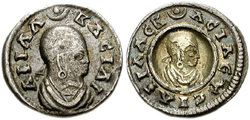
Aphilas (early 4th century) was a king of Axum. He is known from the coins he minted, which are characterized by a number of experiments in imagery on the obverse, and being issued in fractions of weight that none of his successors copied.[1]
G.W.B. Huntingford suggests that he was the ruler who erected the anonymous inscription at Adulis known as the Monumentum Adulitanum.[2]
Aphilas produced the smallest gold coins ever minted in sub-saharan Africa, equivalent to one sixteenth of a Roman aureus. The obverse of this coin features not only his portrait, but the crescent and disc symbolic of the pre-Christian beliefs of Axum. The reverse features his name and title rendered in Greek, the lingua-franca of the civilized world at that time. Note that the "A"s lack a horizontal crossbar but have a dot placed below them instead.
His silver coin features his portrait on both the obverse and reverse with the disc and crescent (at top). The reverse revals a distinguishing festure of Axumite coinage; gilding. The reverse interior portrait is overlaid with gold.
Notes
G.W.B. Huntingford suggests that he was the ruler who erected the anonymous inscription at Adulis known as the Monumentum Adulitanum.[2]
Aphilas produced the smallest gold coins ever minted in sub-saharan Africa, equivalent to one sixteenth of a Roman aureus. The obverse of this coin features not only his portrait, but the crescent and disc symbolic of the pre-Christian beliefs of Axum. The reverse features his name and title rendered in Greek, the lingua-franca of the civilized world at that time. Note that the "A"s lack a horizontal crossbar but have a dot placed below them instead.
His silver coin features his portrait on both the obverse and reverse with the disc and crescent (at top). The reverse revals a distinguishing festure of Axumite coinage; gilding. The reverse interior portrait is overlaid with gold.
Notes
Wazeba
fl. early 4th century
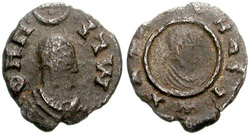
Wazeba (early 4th century) was a king of Axum in northeastern Africa. He is primarily known from the coins he minted during his reign. He was the first king to write the legends of his coins in Ge'ez, and the only king of Axum to use that language on his gold currency.[1]
S. C. Munro-Hay suggests, based on a number of recovered coins that use a die from Wazeba on the obverse and a die from Ousanas on the reverse, that these two kings may have been co-rulers.[2]
Notes
S. C. Munro-Hay suggests, based on a number of recovered coins that use a die from Wazeba on the obverse and a die from Ousanas on the reverse, that these two kings may have been co-rulers.[2]
Notes
Ousanas
c. 320
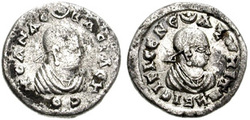
Ousanas (c.320) was a king of Axum. S. C. Munro-Hay believes that it is "very likely" that Ousanas is the king to whom Aedesius and Frumentius were brought; this king is called in Ethiopian tradition "Ella Allada" or Ella Amida.[1] "Ella Amida" would then be his throne name, although "Ousanas" is the name that appears on his coins. If this identification is correct, then it was during his reign that Christianity was introduced to Axum and the surrounding communities.
W.R.O. Hahn, in a study published in 1983, identifies Sembrouthes, who is known only from an inscription found in Daqqi Mahari in modern Eritrea with Ousanas. If correct, this would give Ousanas a reign of at least 27 years.[2]
Coins with the name of this ruler were found in the late 1990s at archeological sites in India.[3
Notes
W.R.O. Hahn, in a study published in 1983, identifies Sembrouthes, who is known only from an inscription found in Daqqi Mahari in modern Eritrea with Ousanas. If correct, this would give Ousanas a reign of at least 27 years.[2]
Coins with the name of this ruler were found in the late 1990s at archeological sites in India.[3
Notes
- ^ S. C. Munro-Hay, Aksum: An African Civilization of Late Antiquity (Edinburgh: University Press, 1991), p.77. (Online text.)
- ^ As cited in Munro-Hay, Excavations at Axum (London: British Institute in Eastern Africa, 1989), p. 22.
- ^ Details in Paul B. Henze, Layers of Time: A History of Ethiopia (New York: Palgrave, 2000), p. 31 n.18.
Ezana
c. 333 - c. 356
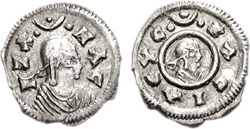
Ezana of Axum (Axumite Kingdom (320s – c.360) located in present-day Tigray, northern Ethiopia, Eritrea, Yemen, he himself employed the style "king of Saba and Salhen, Himyar and Dhu-Raydan.".[1] Tradition states that Ezana succeeded his father Ella Amida (Ousanas) while still a child and his mother, Sofya served as regent. He was the first monarch of Axum to embrace Christianity, and the first after Zoskales to be mentioned by contemporary historians, a situation that led S. C. Munro-Hay to comment that he was "the most famous of the Aksumite kings before Kaleb."[2] He appointed his childhood tutor, the Syrian Christian Frumentius, head of the Ethiopian Church. A surviving letter from the Arian Roman Emperor Constantius II is addressed to 'Ezana and his brother Se'azana, and requests that Frumentius be sent to Alexandria to be examined for doctrinal errors; Munro-Hay assumes that 'Ezana either refused or ignored this request.[3]
Greek inscription of Ezana recording his defeat of various neighboring peoples. 'Ezana also launched several military campaigns, which he recorded in his inscriptions. A pair of inscriptions in Ge'ez have been found at Meroe, which is understood as evidence of a campaign in the fourth century, either during 'Ezana's reign, or by a predecessor like Ousanas. While some authorities interpret these inscriptions as proof that the Axumites destroyed the Kingdom of Kush, others note that archeological evidence points to an economic and political decline in Meroe around 300.[4]
On some of the coins minted in his reign appear the motto in Greek TOYTOAPECHTHXWPA – "May this please the people". Munro-Hay comments that this motto is "a rather attractive peculiarity of Aksumite coinage, giving a feeling of royal concern and responsibility towards the people's wishes and contentment".[5] A number of coins minted bearing his name were found in the late 1990s at archeological sites in India, indicating trade contacts in that country.[6] A remarkable feature of the coins is a shift from a pagan motif with disc and crescent to a design with a cross. 'Ezana is also credited for erecting several structures and obelisks.
'Ezana is unknown in the King Lists even though the coins bear this name. According to tradition, Emperors 'Abreha and 'Asbeha ruled Ethiopia when Christianity was introduced. It may be that these names were later applied to 'Ezana and his brother or that these were their baptismal names.[7]
He is, with his brother, Se'azana, regarded as a saint by the Ethiopian Orthodox Tewahedo Church, with a feast day of October 1.[8]
References
Greek inscription of Ezana recording his defeat of various neighboring peoples. 'Ezana also launched several military campaigns, which he recorded in his inscriptions. A pair of inscriptions in Ge'ez have been found at Meroe, which is understood as evidence of a campaign in the fourth century, either during 'Ezana's reign, or by a predecessor like Ousanas. While some authorities interpret these inscriptions as proof that the Axumites destroyed the Kingdom of Kush, others note that archeological evidence points to an economic and political decline in Meroe around 300.[4]
On some of the coins minted in his reign appear the motto in Greek TOYTOAPECHTHXWPA – "May this please the people". Munro-Hay comments that this motto is "a rather attractive peculiarity of Aksumite coinage, giving a feeling of royal concern and responsibility towards the people's wishes and contentment".[5] A number of coins minted bearing his name were found in the late 1990s at archeological sites in India, indicating trade contacts in that country.[6] A remarkable feature of the coins is a shift from a pagan motif with disc and crescent to a design with a cross. 'Ezana is also credited for erecting several structures and obelisks.
'Ezana is unknown in the King Lists even though the coins bear this name. According to tradition, Emperors 'Abreha and 'Asbeha ruled Ethiopia when Christianity was introduced. It may be that these names were later applied to 'Ezana and his brother or that these were their baptismal names.[7]
He is, with his brother, Se'azana, regarded as a saint by the Ethiopian Orthodox Tewahedo Church, with a feast day of October 1.[8]
References
- ^ S. C. Munro-Hay, Aksum: An African Civilization of Late Antiquity (Edinburgh: University Press, 1991), p. 81. ISBN 0-7486-0106-6
- ^ Munro-Hay, Aksum, p. 77
- ^ Munro-Hay, Aksum, pp. 78ff
- ^ Munro-Hay, Aksum, pp. 79, 224.
- ^ Munro-Hay, Aksum, p. 192.
- ^ Details in Paul B. Henze, Layers of Time: A History of Ethiopia (New York: Palgrave, 2000), p. 31 n.18.
- ^ See "'Ezana" article on Dictionary of African Christian Biography (http://www.dacb.org) Web site at http://www.dacb.org/stories/ethiopia/_ezana.html
- ^ Holweck, F. G., A Biographical Dictionary of the Saints. St. Louis, MO: B. Herder Book Co. 1924
MHDYS (vocalized as "Mehadeyis")
c. 350
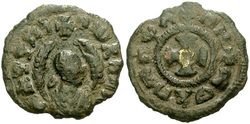
MHDYS (vocalized by historians as Mehadeyis) was a king of Axum (c.360). He is primarily known through the coins minted during his reign.
Mehadeyis restored Ge'ez as the language used on all his coins. Munro-Hay notes that the legend upon his bronze coins, "bzmsql tmw" "by this cross you will conquer" was a loose translation of the famous motto of Emperor Constantine the Great, In hoc signo vinces ("By this sign you will conquer.")[1]
See also References
Mehadeyis restored Ge'ez as the language used on all his coins. Munro-Hay notes that the legend upon his bronze coins, "bzmsql tmw" "by this cross you will conquer" was a loose translation of the famous motto of Emperor Constantine the Great, In hoc signo vinces ("By this sign you will conquer.")[1]
See also References
- ^ Munro-Hay, Stuart. Aksum: An African Civilization of Late Antiquity (Edinburgh: University Press, 1991), p. 81.
Ouazebas
fl. late 4th century
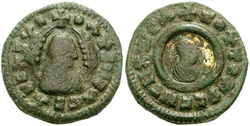
Ouazebas (late 4th century) was a king of Axum. He is primarily known through the coins minted during his reign.
His coins were found beneath the remains of the largest stela at the city of Axum, indicating that it had fallen as early as his reign. S. C. Munro-Hay suggests that this particular stela was the last one erected, and that "possibly they went out of favor as Christianity spread, bringing with it new ideas about burial.[1]
Ouzanebas reintroduced on his coins a motto from the time of Ezana, TOYTOAPECHTHXWPA -- "May this please the people". Munro-Hay comments that this motto is "a rather attractive peculiarity of Aksumite coinage, giving a feeling of royal concern and responsibility towards the people's wishes and contentment".[2]
Notes
His coins were found beneath the remains of the largest stela at the city of Axum, indicating that it had fallen as early as his reign. S. C. Munro-Hay suggests that this particular stela was the last one erected, and that "possibly they went out of favor as Christianity spread, bringing with it new ideas about burial.[1]
Ouzanebas reintroduced on his coins a motto from the time of Ezana, TOYTOAPECHTHXWPA -- "May this please the people". Munro-Hay comments that this motto is "a rather attractive peculiarity of Aksumite coinage, giving a feeling of royal concern and responsibility towards the people's wishes and contentment".[2]
Notes
Eon possibly the "Huina" from the Book of the Himyarites
c. 400
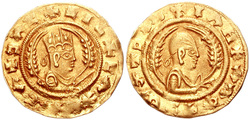
Eon (c. 400) was a king of Axum. He is primarily known through the coins minted during his reign, where his name is written in Greek as "Eon Bisi Anaaph". While "bisi Anaaph" is usually understood to mean "man of Anaaph", Richard Pankhurst notes that the scholar Stephen Wright has argued the word bisi "might well be used in relation to the King's horse in the same way that Ethiopians of much later times used the word Aba. Sahle Sellassie, for example, was often known as Aba Dina (Dina being the name of his favorite horse)."[1]
Eon may be the same person as the King Hiuna, who is mentioned in the Book of the Himyarites as leading a military expedition from Aksum across the Red Sea into South Arabia; Munro-Hay notes that the "difference in spelling is no more than would result from transposing the name into the two languages concerned"; but he admits that the identification is not conclusive, or whether Hiuna was even a king.[2]
Eon was the first king of Axum to use the mysterious title + BAC + CIN + BAX + ABA, which Munro-Hay reports has been interpreted to mean Basileus habasinon -- "King of the Habashat/Habash", a title used in South Arabian inscriptions to refer to the Axumite kings.[2]
Notes
Eon may be the same person as the King Hiuna, who is mentioned in the Book of the Himyarites as leading a military expedition from Aksum across the Red Sea into South Arabia; Munro-Hay notes that the "difference in spelling is no more than would result from transposing the name into the two languages concerned"; but he admits that the identification is not conclusive, or whether Hiuna was even a king.[2]
Eon was the first king of Axum to use the mysterious title + BAC + CIN + BAX + ABA, which Munro-Hay reports has been interpreted to mean Basileus habasinon -- "King of the Habashat/Habash", a title used in South Arabian inscriptions to refer to the Axumite kings.[2]
Notes
Ebana
fl. 5th century
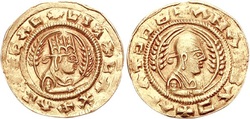
Paragraph. Fai clic qui per effettuare modifiche.
Nezool also called "Nezana"
fl. 5th century
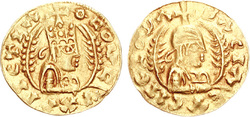
Nezool (fl. 5th century) was a king of Axum. He is primarily known from the coins minted during his reign, where his name also appears as Nezana.
Munro-Hay reports a theory that Nezool and Nezana were actually the names of a pair of kings who shared in a dual reign. While he presents the possibility, he does not offer another opinion on the subject.[1]
Notes
Munro-Hay reports a theory that Nezool and Nezana were actually the names of a pair of kings who shared in a dual reign. While he presents the possibility, he does not offer another opinion on the subject.[1]
Notes
- ^ S. C. Munro-Hay, Aksum: An African Civilization of Late Antiquity (Edinburgh: University Press, 1991), pp. 156f.
Ousas also spelled "Ousana(s)" possibly Tazena, father of Kaleb
c. 500
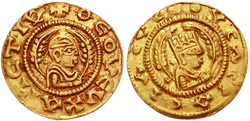
Ousas or Ousana(s) (c.500) was a king of Axum. He is primarily known from the coins minted during his reign.
Because the gold coins issued with this king's name closely resemble those of King Kaleb, Munro-Hay suggests that Ousas may be another name of Tazena, who is described both in Ethiopian tradition and on Kaleb's coins as his father.[1]
Notes
Because the gold coins issued with this king's name closely resemble those of King Kaleb, Munro-Hay suggests that Ousas may be another name of Tazena, who is described both in Ethiopian tradition and on Kaleb's coins as his father.[1]
Notes
- ^ S. C. Munro-Hay, Aksum: An African Civilization of Late Antiquity (Edinburgh: University Press, 1991), pp. 84, 88.
Kaleb tradition names his son Gabra Masqal
c. 520
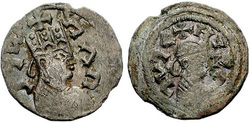
Kaleb (c.520) is perhaps the best-documented, if not best-known, king of Axum. Procopius of Caesarea calls him "Hellestheaeus", a variant of his throne name Ella Atsbeha or Ella Asbeha (Histories, 1.20). On both his coins and inscriptions he left at Axum, as well as Ethiopian hagiographical sources and king lists, he refers to himself as the son of Tazena.[1] He may be the "Atsbeha" or "Asbeha" of the Ethiopian legends of Abreha and Asbeha, the other possibility being Ezana's brother Saizana.
Procopius, John of Ephesus, and other contemporary historians recount his invasion of Yemen around 520, against the Jewish Himyarite king Yusuf Asar Yathar (also known as Dhu Nuwas), who was persecuting the Christians in his kingdom. After much fighting, Kaleb's soldiers eventually routed Yusuf's forces and killed the king, allowing Kaleb to appoint Sumuafa' Ashawa', a native Christian (named Esimphaios by Procopius), as his viceroy of Himyar. As a result of his protection of the Christians, he is known as St. Elesbaan after the sixteenth-century Cardinal Cesare Baronio added him to his edition of the Roman Martyrology despite his being a Monophysite and therefore in Roman Catholic eyes a heretic.[2][3][4] However, the question of whether Miaphysitism—the actual christology of the Oriental Orthodox Churches (including the Coptic Orthodox Church)—was a heresy is a question which remains to this day, and other Oriental saints such as Isaac of Nineveh continue to be venerated by the Chalcedonian churches.
Axumite control of South Arabia continued until c.525 when Sumuafa' Ashawa' was deposed by Abraha, who made himself king. Procopius states that Kaleb made several unsuccessful attempts to recover his overseas territory; however, his successor later negotiated a peace with Abraha, where Abraha acknowledged the Axumite king's authority and paid tribute. Munro-Hay opines that by this expedition Axum overextended itself, and this final intervention across the Red Sea, "was Aksum's swan-song as a great power in the region."[5]
A reference map of the empire of Kaleb of Axum. Ethiopian tradition states that Kaleb eventually abdicated his throne, gave his crown to the Church of the Holy Sepulchre at Jerusalem, and retired to a monastery.[6]
Later historians who recount the events of King Kaleb's reign include Ibn Hisham, Ibn Ishaq, and Tabari. Taddesse Tamrat records a tradition he heard from an aged priest in Lalibela that "Kaleb was a man of Lasta and his palace was at Bugna where it is known that Gebre Mesqel Lalibela had later established his centre. The relevance of this tradition for us is the mere association of the name of Kaleb with the evangelization of this interior province of Aksum."[7]
Besides several inscriptions bearing his name,[8] Axum also contains a pair of ruined structures, one said to be his tomb and its partner said to be the tomb of his son Gabra Masqal. (Tradition gives him a second son, Israel, whom it has been suggested is identical with the Axumite king Israel.[9]) This structure was first examined as an archaeological subject by Henry Salt in the early 19th century; almost a century later, it was partially cleared and mapped out by the Deutsche Aksum-Expedition in 1906. The most recent excavation of this tomb was in 1973 by the British Institute in East Africa.[10]
The Eastern Orthodox Church commemorates Kaleb as "Saint Elesbaan, king of Ethiopia" on October 24 (for those churches which follow the Julian Calendar, October 24 falls on November 6 of the Gregorian Calendar).
See also
Procopius, John of Ephesus, and other contemporary historians recount his invasion of Yemen around 520, against the Jewish Himyarite king Yusuf Asar Yathar (also known as Dhu Nuwas), who was persecuting the Christians in his kingdom. After much fighting, Kaleb's soldiers eventually routed Yusuf's forces and killed the king, allowing Kaleb to appoint Sumuafa' Ashawa', a native Christian (named Esimphaios by Procopius), as his viceroy of Himyar. As a result of his protection of the Christians, he is known as St. Elesbaan after the sixteenth-century Cardinal Cesare Baronio added him to his edition of the Roman Martyrology despite his being a Monophysite and therefore in Roman Catholic eyes a heretic.[2][3][4] However, the question of whether Miaphysitism—the actual christology of the Oriental Orthodox Churches (including the Coptic Orthodox Church)—was a heresy is a question which remains to this day, and other Oriental saints such as Isaac of Nineveh continue to be venerated by the Chalcedonian churches.
Axumite control of South Arabia continued until c.525 when Sumuafa' Ashawa' was deposed by Abraha, who made himself king. Procopius states that Kaleb made several unsuccessful attempts to recover his overseas territory; however, his successor later negotiated a peace with Abraha, where Abraha acknowledged the Axumite king's authority and paid tribute. Munro-Hay opines that by this expedition Axum overextended itself, and this final intervention across the Red Sea, "was Aksum's swan-song as a great power in the region."[5]
A reference map of the empire of Kaleb of Axum. Ethiopian tradition states that Kaleb eventually abdicated his throne, gave his crown to the Church of the Holy Sepulchre at Jerusalem, and retired to a monastery.[6]
Later historians who recount the events of King Kaleb's reign include Ibn Hisham, Ibn Ishaq, and Tabari. Taddesse Tamrat records a tradition he heard from an aged priest in Lalibela that "Kaleb was a man of Lasta and his palace was at Bugna where it is known that Gebre Mesqel Lalibela had later established his centre. The relevance of this tradition for us is the mere association of the name of Kaleb with the evangelization of this interior province of Aksum."[7]
Besides several inscriptions bearing his name,[8] Axum also contains a pair of ruined structures, one said to be his tomb and its partner said to be the tomb of his son Gabra Masqal. (Tradition gives him a second son, Israel, whom it has been suggested is identical with the Axumite king Israel.[9]) This structure was first examined as an archaeological subject by Henry Salt in the early 19th century; almost a century later, it was partially cleared and mapped out by the Deutsche Aksum-Expedition in 1906. The most recent excavation of this tomb was in 1973 by the British Institute in East Africa.[10]
The Eastern Orthodox Church commemorates Kaleb as "Saint Elesbaan, king of Ethiopia" on October 24 (for those churches which follow the Julian Calendar, October 24 falls on November 6 of the Gregorian Calendar).
See also
Alla Amidas
fl. mid 6th century

Alla Amidas (c.540) was a king of Axum. He is primarily known from the coins minted during his reign.
Due to die-links between the coins of Alla Amidas and Kaleb, Munro-Hay suggests that the two kings were co-rulers, Alla Amidas possibly ruling the African territories while Kaleb was across the Red Sea campaigning in South Arabia.[1]
Notes
Due to die-links between the coins of Alla Amidas and Kaleb, Munro-Hay suggests that the two kings were co-rulers, Alla Amidas possibly ruling the African territories while Kaleb was across the Red Sea campaigning in South Arabia.[1]
Notes
- ^ S. C. Munro-Hay, Aksum: An African Civilization of Late Antiquity (Edinburgh: University Press, 1991), pp. 156f.
Wazena
_fl. mid 6th century
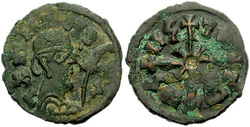
Wazena (mid 6th century) was a king of Axum. He is primarily known through the coins minted during his reign. Without any clear discussion, Munro-Hay identifies him with a king Alla Amidas, who is also known only through the coins he issued.[1]
Notes
Notes
- ^ Munro-Hay Aksum: An African Civilization of Late Antiquity (Edinburgh: University Press, 1991), p. 84.
W`ZB vocalized as "Wa`zeb" - possibly "Ella Gabaz", son of Kaleb

W`ZB (vocalized as Wa`zeb) or Ella Gabaz was a king of Axum (flourished mid 6th century). He uses the name "Ella Gabaz" on his coinage, but calls himself W`ZB in an inscription where he states he is the "son of Ella Atsbeha", or king Kaleb.[1]
In his discussion of this king, Munro-Hay draws on material from the story of Abba Libanos, the "Apostle of Eritrea", in which a king named "Za-Gabaza Aksum" is mentioned, to suggest that Ella Gabaz and Za-Gabaza might be epithets W`ZB adopted, and indicate that he did some important construction on Mariam Syon (or Church of Our Lady Mary of Zion) in Axum.[2]
Notes .
In his discussion of this king, Munro-Hay draws on material from the story of Abba Libanos, the "Apostle of Eritrea", in which a king named "Za-Gabaza Aksum" is mentioned, to suggest that Ella Gabaz and Za-Gabaza might be epithets W`ZB adopted, and indicate that he did some important construction on Mariam Syon (or Church of Our Lady Mary of Zion) in Axum.[2]
Notes .
Loel
fl. mid 6th century
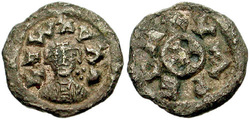
Ioel (mid 6th century) was a king of Axum. He is primarily known through the coins minted during his reign.
Hataz identified with "Iathlia"
c. 575
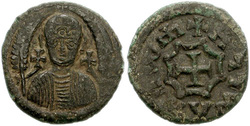
Hataz (c.575) was a king of Axum. He is primarily known through the coins minted during his reign, some of which call him Iathlia.
Saifu
c. 577

Saifu (c.577) was a king of Axum.
He is known from a chance mention in a Chinese biography of Mohammed, the T'ien-fang Chih-sheng shih-lu, written between 1721 and 1724 by Liu Chih. This work uses older materials that have been traced to a biography of the prophet written by Sa'id al-Din Mohammed bin Mas'ud bin Mohammad al-Kazarumi, who died in 1357. According to this Chinese biography, the najashi of Ethiopia was said to have sent an ambassador with gifts to Mohammed's family upon sighting a star that announced his birth. When Mohammed became seven years old, Saifu, described as the najashi's grandson, likewise sent gifts. This source also adds that Saifu was the grandfather of the najashi who gave shelter to the Muslim emigrants around 615-6 at Axum.
In reporting the contents of this "very tentative" source, Munro-Hay speculates how this genealogical relationship around Saifu might fit the known series of rulers in the later 6th century (identifying Saifu's grandfather with Kaleb, and his grandson with Ashama ibn Abjar), and appears to admit that these details are plausible.
Notes
He is known from a chance mention in a Chinese biography of Mohammed, the T'ien-fang Chih-sheng shih-lu, written between 1721 and 1724 by Liu Chih. This work uses older materials that have been traced to a biography of the prophet written by Sa'id al-Din Mohammed bin Mas'ud bin Mohammad al-Kazarumi, who died in 1357. According to this Chinese biography, the najashi of Ethiopia was said to have sent an ambassador with gifts to Mohammed's family upon sighting a star that announced his birth. When Mohammed became seven years old, Saifu, described as the najashi's grandson, likewise sent gifts. This source also adds that Saifu was the grandfather of the najashi who gave shelter to the Muslim emigrants around 615-6 at Axum.
In reporting the contents of this "very tentative" source, Munro-Hay speculates how this genealogical relationship around Saifu might fit the known series of rulers in the later 6th century (identifying Saifu's grandfather with Kaleb, and his grandson with Ashama ibn Abjar), and appears to admit that these details are plausible.
Notes
- ^ S. C. Munro-Hay, Aksum: An African Civilization of Late Antiquity (Edinburgh: University Press, 1991), p. 93
Israel - traditon also records an Israel, son of Kaleb
c. 590
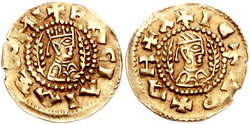
Israel (vocalized 590) was a king of Axum. He is primarily known through the coins minted during his reign.
The Kebra Nagast and Ethiopian historical tradition states that Kaleb had two sons, Gabra Masqal and Israel. Skeptical that this Israel was actually the son of King Kaleb, Munro-Hay suggests that Israel may have been better than the other kings between him and Kaleb (or Gabra Masqal), and tradition compressed the succession.[1] Richard Pankhurst mentions the name of this king as an early example of Judaic influence in Ethiopian culture.[2]
Notes
The Kebra Nagast and Ethiopian historical tradition states that Kaleb had two sons, Gabra Masqal and Israel. Skeptical that this Israel was actually the son of King Kaleb, Munro-Hay suggests that Israel may have been better than the other kings between him and Kaleb (or Gabra Masqal), and tradition compressed the succession.[1] Richard Pankhurst mentions the name of this king as an early example of Judaic influence in Ethiopian culture.[2]
Notes
Gersem
c. 600
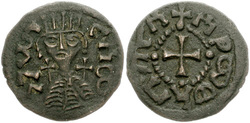
Gersem (c.600) was a king of Axum in northeastern Africa. He is primarily known through the coins minted during his reign.
Munro-Hay states that either he or Armah were the last Axumite kings to issue coins. In either case, no gold coins of Armah have been found, and Gersem is assumed to be the last coin in gold.
Notes
Munro-Hay states that either he or Armah were the last Axumite kings to issue coins. In either case, no gold coins of Armah have been found, and Gersem is assumed to be the last coin in gold.
Notes
- S. C. Munro-Hay, Aksum: An African Civilization of Late Antiquity (Edinburgh: University Press, 1991), p. 91.
Armah possibly identical with Ashama ibn Abjar
c. 614
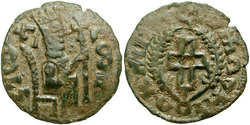
Armah (c.614) was a king of Axum. He is primarily known through the coins minted during his reign,[1] although it has been suggested as long ago as 1895 that he was identical to Ashama ibn Abjar, who gave shelter to the Muslim emigrants around 615-6 at Axum.
Munro-Hay states that either he or Gersem were the last Axumite kings to issue coins. In either case, no gold coins of Armah have been found, and Munro-Hay speculates that "he had accepted that there was no purpose in producing them, as his kingdom was by now at least in part cut off from the Byzantine trade network."
Armah's silver coins have an unusual reverse, showing a structure with three crosses, the middle one gilded, that Munro-Hay quotes W.R.O. Hahn as suggesting that this refers to the Holy Sepulchre, as a reference to the Persian capture of Jerusalem in 614; if this is correct, it provides a date for Armah.[2]
Notes
Munro-Hay states that either he or Gersem were the last Axumite kings to issue coins. In either case, no gold coins of Armah have been found, and Munro-Hay speculates that "he had accepted that there was no purpose in producing them, as his kingdom was by now at least in part cut off from the Byzantine trade network."
Armah's silver coins have an unusual reverse, showing a structure with three crosses, the middle one gilded, that Munro-Hay quotes W.R.O. Hahn as suggesting that this refers to the Holy Sepulchre, as a reference to the Persian capture of Jerusalem in 614; if this is correct, it provides a date for Armah.[2]
Notes
- ^ A letter to Antoine d'Abbadie, dated 8 January 1869, mentions a coin of this ruler. Sven Rubenson, Acta Aethiopica, vol 3: Internal Rivalries and Foreign Threats, 1869-1879 (Addis Ababa: University Press, 2000), p. 3
- ^ This article is based on S. C. Munro-Hay's discussion in his Aksum: An African Civilization of Late Antiquity (Edinburgh: University Press, 1991), p. 91.
Ashama ibn Abjar tradition also records an Ella Tsaham (Illa Ṣaḥām)
died c. 630

According to Arabic sources, Aṣḥama ibn Abjar was Emperor or al-Najashi (Arabic: النجاشي) of Aksum at the time of Muhammad, and gave refuge to several Muslims in the Kingdom of Aksum. The term "al-Najashi" has the variant al-Negashi; it corresponds to the ancient Aksumite title Negus, with the variant Negash. The name "Ashama"Ashama ibn Abjar seems to correspond to the original Ge'ez name Ella-Seham, variant Sahama. This is an Aksumite king known from coinage.[1] According to other authors, Ashama may have been the same person as king Armah, or his father or son.[2] Taddesse Tamrat records that the inhabitants of Wiqro, where he is known as Ashamat al-Negashi claim his tomb is located in their village.
Islamic tradition
Main article: Migration to Abyssinia Due to persecution from the current Arab leadership in Mecca, a number of Muslims emigrated to Abyssinia. In response, the Arab leaders sent Amr ibn al-Aas to bring them back. Amr was a friend of al-Najashi, and at the same time also had good relations with Abu Sufyan, the then leader of Quraish.
Ashama did not act in a hurry but showed patience and demanded the holy scripture of Muslims to be read. At this, Ja`far ibn Abi Talib recited some verses from the Quran from the chapter of Maryam (Mary). According to Ibn Hisham, al-Najashi and the priests in his court were greatly affected by the touching verses that they began to shed tears. And so, al-Najashi firmly denied Amr's request to be handed the Muslim refugees. The very next day, Amr tried to play a trick, in order to sow dissension between al-Najashi and the Muslim refugees. Amr was greatly distressed, and promised Ja`far and other Muslims that he's going to cause a great schism between them and King Ashama. Amr arrived the next day at the court of Ashama, and demanded in his presence that the Muslims make known their creed about Jesus. This was a difficult situation because Jesus is not considered as the son of God in the Qur'an, and that was expected to greatly enrage a devout Christian like King Ashama. To this, he explained that Jesus is considered in Islam to be a messenger of God, the word of God, and the miraculously born son of the Virgin Mary. In reply to this statement, King Ashama made a line on the sand with his mace and said, "By God, Jesus is not more than what you have described him. By God, I will never give you up to anyone." He then declared that Muslims could live in Abyssinia for as long as they wished for. According to Muslim tradition, it is during this situation that King Ashama converted to Islam. However, such a conversion is not corroborated by independent historical sources[citation needed].
Some accounts state that Ashama read the Nikah at one of Muhammad's marriages.[4]
The Sahabī Abu Huraira narrates that Muhammad announced the death of al-Najashi (Ashama, cp. Negus, Negusa Nagast) on the same day that he died, and even before any news became known about it for anyone in the city.
In a letter from Muhammad to Negus, king of Abyssinia (Ethiopia), Muhammad invites Negus and his men to follow his message and believe in Allah. (Ibn al-Qayyim - Zad al-Ma'ad 3/60). When this letter was presented to Negus, he took the parchment and placed it on his eye, descended to the floor, confessed his faith in Islam. He then responded to [Muhammad] acknowledging him as the Messenger of Allâh and surrendering himself "through him to the Lord of the worlds."(Ibn al-Qayyim - Zad al-Ma'ad 3/61)
Islamic scholar al-Nawawi wrote in his Commentary on Sahih Muslim that Imam Shafi`i and those who agree to his doctrine in fiqh see in this hadith a proof for praying in absence over a dead Muslim. There is in the hadith an evident miracle of the Prophet's due to his proclamation of the Negus's death on the same day that the latter died in Abyssinia. There is also in the hadith the desirability of proclaiming the death of someone, but not in the pre-Islamic fashion which means to glorify and so forth.[5]
Muhammad had asked the Negus to send Ja‘far and his companions, the emigrants to Abyssinia, back home. They came back to see [Muhammad] in Khaibar. Negus later died in Rajab 9, A.H. shortly after the Ghazwa of Tabuk. [Muhammad] announced his death and observed prayer in absentia for him.
Another king succeeded Negus to the throne and another letter was sent to him by [Muhammad] but whether or not he embraced Islam is still a question not answered yet.(Sahih Muslim 2/99)
Font: wikipedia
Islamic tradition
Main article: Migration to Abyssinia Due to persecution from the current Arab leadership in Mecca, a number of Muslims emigrated to Abyssinia. In response, the Arab leaders sent Amr ibn al-Aas to bring them back. Amr was a friend of al-Najashi, and at the same time also had good relations with Abu Sufyan, the then leader of Quraish.
Ashama did not act in a hurry but showed patience and demanded the holy scripture of Muslims to be read. At this, Ja`far ibn Abi Talib recited some verses from the Quran from the chapter of Maryam (Mary). According to Ibn Hisham, al-Najashi and the priests in his court were greatly affected by the touching verses that they began to shed tears. And so, al-Najashi firmly denied Amr's request to be handed the Muslim refugees. The very next day, Amr tried to play a trick, in order to sow dissension between al-Najashi and the Muslim refugees. Amr was greatly distressed, and promised Ja`far and other Muslims that he's going to cause a great schism between them and King Ashama. Amr arrived the next day at the court of Ashama, and demanded in his presence that the Muslims make known their creed about Jesus. This was a difficult situation because Jesus is not considered as the son of God in the Qur'an, and that was expected to greatly enrage a devout Christian like King Ashama. To this, he explained that Jesus is considered in Islam to be a messenger of God, the word of God, and the miraculously born son of the Virgin Mary. In reply to this statement, King Ashama made a line on the sand with his mace and said, "By God, Jesus is not more than what you have described him. By God, I will never give you up to anyone." He then declared that Muslims could live in Abyssinia for as long as they wished for. According to Muslim tradition, it is during this situation that King Ashama converted to Islam. However, such a conversion is not corroborated by independent historical sources[citation needed].
Some accounts state that Ashama read the Nikah at one of Muhammad's marriages.[4]
The Sahabī Abu Huraira narrates that Muhammad announced the death of al-Najashi (Ashama, cp. Negus, Negusa Nagast) on the same day that he died, and even before any news became known about it for anyone in the city.
In a letter from Muhammad to Negus, king of Abyssinia (Ethiopia), Muhammad invites Negus and his men to follow his message and believe in Allah. (Ibn al-Qayyim - Zad al-Ma'ad 3/60). When this letter was presented to Negus, he took the parchment and placed it on his eye, descended to the floor, confessed his faith in Islam. He then responded to [Muhammad] acknowledging him as the Messenger of Allâh and surrendering himself "through him to the Lord of the worlds."(Ibn al-Qayyim - Zad al-Ma'ad 3/61)
Islamic scholar al-Nawawi wrote in his Commentary on Sahih Muslim that Imam Shafi`i and those who agree to his doctrine in fiqh see in this hadith a proof for praying in absence over a dead Muslim. There is in the hadith an evident miracle of the Prophet's due to his proclamation of the Negus's death on the same day that the latter died in Abyssinia. There is also in the hadith the desirability of proclaiming the death of someone, but not in the pre-Islamic fashion which means to glorify and so forth.[5]
Muhammad had asked the Negus to send Ja‘far and his companions, the emigrants to Abyssinia, back home. They came back to see [Muhammad] in Khaibar. Negus later died in Rajab 9, A.H. shortly after the Ghazwa of Tabuk. [Muhammad] announced his death and observed prayer in absentia for him.
Another king succeeded Negus to the throne and another letter was sent to him by [Muhammad] but whether or not he embraced Islam is still a question not answered yet.(Sahih Muslim 2/99)
Font: wikipedia
The following list of rulers between 600-900 (dates not available) is based on E. A. Wallis Budge, A History of Ethiopia: Nubia and Abyssinia, 1928 (Oosterhout, the Netherlands: Anthropological Publications, 1970)
Kwastantinos or "Constantine"

Paragraph. Fai clic qui per effettuare modifiche.
Wasan Sagad Bazagar?

Paragraph. Fai clic qui per effettuare modifiche.
Fere Shanay or Fere Shernay

Paragraph. Fai clic qui per effettuare modifiche.
'Adre'az or 'Adre'azar

Paragraph. Fai clic qui per effettuare modifiche.
'Akla Wedem

Paragraph. Fai clic qui per effettuare modifiche.
Germa Safar

Paragraph. Fai clic qui per effettuare modifiche.
Zergaz or Gergaz

Paragraph. Fai clic qui per effettuare modifiche.
Degna Mikael

Paragraph. Fai clic qui per effettuare modifiche.
Bahr Ikela

Paragraph. Fai clic qui per effettuare modifiche.
Gum

Paragraph. Fai clic qui per effettuare modifiche.
'Asgwomgum

Paragraph. Fai clic qui per effettuare modifiche.
Letem

Paragraph. Fai clic qui per effettuare modifiche.
Talatem

Paragraph. Fai clic qui per effettuare modifiche.
'Oda Gosh or 'Oda Sasa

Paragraph. Fai clic qui per effettuare modifiche.
'Ayzur

who reigned half a day and was strangled to death
Dedem

Paragraph. Fai clic qui per effettuare modifiche.
Wededem

Paragraph. Fai clic qui per effettuare modifiche.
Wedem 'Asfare

Paragraph. Fai clic qui per effettuare modifiche.
'Armah

Paragraph. Fai clic qui per effettuare modifiche.
Degna Djan

Paragraph. Fai clic qui per effettuare modifiche.
'Anbasa Wedem

Paragraph. Fai clic qui per effettuare modifiche.
Dil Na'od

Del-Nä'ad, or Del-na'od, Emperor (perhaps fl. 9th or 10th century A.D.), was, according to many traditional sources, the last ruler of the Solomonic line before the usurpation by the Zagwé. Although many different traditions relating to this king have survived, they are not necessarily mutually contradictory. Some scholars have conjectured that Del-Nä'ad was the younger son of an Emperor named as Tabtahäj in a reference in the History of the Patriarchs of Alexandria and sometimes identified with Emperor Degna-Zan, and was chosen as his father's successor by Abunä Pétros but was shortly afterwards deposed through the intrigues of his elder brother, sometimes identified as 'Anbässa-Wedem, and of the false Abunä Minas, who then consecrated 'Anbässa-Wede as Emperor. According to this hypothetical reconstruction, the party which favoured Del-Nä'ad may have later succeeded in dethroning 'Anbässa-Wedem and restoring Del-Nä'ad to power. Certain traditions hold, however, that Del-Nä'ad was only a child at the time of the fall of Aksum and that he was taken to safety in northern Säwa or Amhara, where his descendants remained until the restoration of their line in the person of Emperor Yekuno-'Amlak. It may be possible to reconcile the traditions if it is supposed that Del-Nä'ad was very young at the time of his deposition and that, after taking refuge in Säwa or Amhara during his brother's reign, he later returned to rule in Aksum for an indeterminate period before the final collapse of the kingdom. The Paris Chronicle edited by Basset records that Del-Nä'ad was the son of 'Anbässa-Wedem, however, not the younger brother.
While it is clearly impossible to place much reliance upon such traditions, the accretion of legends attached to the semi-legendary figure of Del-Nä'ad seems to indicate that decisive events took place in this period and other widely-known traditions relate Del-Nä'ad's further tribulations to the founding of a new dynasty. Having heard it foretold that the man who married his daughter, Princess Mäsobä-Wärq, would dethrone him, Del-Nä'ad kept her in seclusion. A young man of the family of Hépasa, named Täklä-Haymanot, won the confidence of the king and gained access to the Princess. After marrying her by a ruse, he absconded with her to Lasta - or perhaps Hamasén. He later made war on Del-Nä'ad and seized the kingdom by force.
That Del-Nä'ad spent some time in the area of northern Säwa and Amhara is confirmed by the Gädlä 'Iyäsus-Mo'a, where it is recorded that he built many churches on the shores of a lake. He is said to have founded Däbrä 'Egzi'abehér, at Lake Hayq, at the exhortation of Abunä Sälama Zä-Azéb who came 618 years after the arrival (c. 330 A.D.) of his namesake, Abunä Sälama I, Frumentius. This would enable us to date Del-Nä'ad in mid-tenth century, which accords with Ethiopian tradition on the fall of Aksum. (A date of mid-ninth century has also been postulated as the same chronicler also gives the date of 6362 A.M., i.e. 869/870 A.D. for the construction of the church of St. Stephen by the king, on the grounds that some traditional Ethiopian sources place Frumentius in the third century A.D. rather than in the fourth century, dating the establishment of the church in Aksum at 252/3 A.D. This theory gains some support from a tradition quoted in the Futuh al-Habasha that the church of Däbrä 'Egzi'abehér was built in the early ninth century.) In the Gädlä 'Iyäsus-Mo'a, it is further recorded of Del-Nä'ad that "... in the seventh year of his reign ... [the seat of] the kingdom was tranferred from Aksum to the country of the east."
Belaynesh Michael
Bibliography:
J. Ludolf, (J. P. Gent, trans.), A New History of Ethiopia (London, 1684), Chap. IV, 168.
R. Basset, Etudes sur l'histoire d'Ethiopie (Paris, 1882).
--------(ed.), Futuh al-Habasha (Paris, 1897-1901), 231-232 of text.
J. Perruchon, "Notes pour l'histoire d'Ethiopie," Revue Sémitique, Vol. II (1894): 78-93.
C. Conti Rossini, Storia d'Etiopia (Bergamo, 1928), 262-3, 304-5, 319.
E. A. Wallis Budge, The Book of the Saints of the Ethiopian Church (Cambridge, 1928), Vol. III, 666-8 (Synaxarium, 3 Mäggabit).
--------, A History of Ethiopia (London, 1928), Vol. I, 276.
S. Kur (ed. and trans.), Actes de Iyasus Mo'a, Corpus Scriptorum Christianorum Orientalium, Scriptores aethiopici, t.49 and t. 50.
Taddesse Tamrat, "The Abbots of Däbrä-Hayq 1248-1535," Journal of Ethiopian Studies, Vol. VIII, No. 1 (1970): 87-88.
--------, Church and State in Ethiopia 1270-1527 (Oxford, 1972), 36, 66, n. 3.
While it is clearly impossible to place much reliance upon such traditions, the accretion of legends attached to the semi-legendary figure of Del-Nä'ad seems to indicate that decisive events took place in this period and other widely-known traditions relate Del-Nä'ad's further tribulations to the founding of a new dynasty. Having heard it foretold that the man who married his daughter, Princess Mäsobä-Wärq, would dethrone him, Del-Nä'ad kept her in seclusion. A young man of the family of Hépasa, named Täklä-Haymanot, won the confidence of the king and gained access to the Princess. After marrying her by a ruse, he absconded with her to Lasta - or perhaps Hamasén. He later made war on Del-Nä'ad and seized the kingdom by force.
That Del-Nä'ad spent some time in the area of northern Säwa and Amhara is confirmed by the Gädlä 'Iyäsus-Mo'a, where it is recorded that he built many churches on the shores of a lake. He is said to have founded Däbrä 'Egzi'abehér, at Lake Hayq, at the exhortation of Abunä Sälama Zä-Azéb who came 618 years after the arrival (c. 330 A.D.) of his namesake, Abunä Sälama I, Frumentius. This would enable us to date Del-Nä'ad in mid-tenth century, which accords with Ethiopian tradition on the fall of Aksum. (A date of mid-ninth century has also been postulated as the same chronicler also gives the date of 6362 A.M., i.e. 869/870 A.D. for the construction of the church of St. Stephen by the king, on the grounds that some traditional Ethiopian sources place Frumentius in the third century A.D. rather than in the fourth century, dating the establishment of the church in Aksum at 252/3 A.D. This theory gains some support from a tradition quoted in the Futuh al-Habasha that the church of Däbrä 'Egzi'abehér was built in the early ninth century.) In the Gädlä 'Iyäsus-Mo'a, it is further recorded of Del-Nä'ad that "... in the seventh year of his reign ... [the seat of] the kingdom was tranferred from Aksum to the country of the east."
Belaynesh Michael
Bibliography:
J. Ludolf, (J. P. Gent, trans.), A New History of Ethiopia (London, 1684), Chap. IV, 168.
R. Basset, Etudes sur l'histoire d'Ethiopie (Paris, 1882).
--------(ed.), Futuh al-Habasha (Paris, 1897-1901), 231-232 of text.
J. Perruchon, "Notes pour l'histoire d'Ethiopie," Revue Sémitique, Vol. II (1894): 78-93.
C. Conti Rossini, Storia d'Etiopia (Bergamo, 1928), 262-3, 304-5, 319.
E. A. Wallis Budge, The Book of the Saints of the Ethiopian Church (Cambridge, 1928), Vol. III, 666-8 (Synaxarium, 3 Mäggabit).
--------, A History of Ethiopia (London, 1928), Vol. I, 276.
S. Kur (ed. and trans.), Actes de Iyasus Mo'a, Corpus Scriptorum Christianorum Orientalium, Scriptores aethiopici, t.49 and t. 50.
Taddesse Tamrat, "The Abbots of Däbrä-Hayq 1248-1535," Journal of Ethiopian Studies, Vol. VIII, No. 1 (1970): 87-88.
--------, Church and State in Ethiopia 1270-1527 (Oxford, 1972), 36, 66, n. 3.
